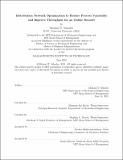Distribution Network Optimization to Reduce Process Variability and Improve Throughput for an Online Retailer
Author(s)
Schoder, Michael T.
DownloadThesis PDF (2.234Mb)
Advisor
Krebs, Hermano Igo
Graves, Stephen C.
Terms of use
Metadata
Show full item recordAbstract
In moving from standard two-day to single-day shipping, Amazon Fulfillment Centers (FC) must stock an increasing variety of product in inventory. Amazon uses a hub and spoke model where Inbound Cross-Dock (IXD) facilities split and ship large quantities of vendor product efficiently to numerous FCs, a process known as transshipment. Depending on the volume of product required for optimal inventory placement at the receiving FC, product may depart an IXD either in its original vendor corrugate case packaging or in an Amazon standard plastic yellow tote if the original case was split apart at the IXD.
Furthermore, case and tote containers may be transshipped either in traditional palletized trailers or in floor loads (trailers loaded directly with stacked cases or totes). In an effort to reduce transportation costs, Amazon is transitioning to using floor loads for an increasing proportion of its North American transshipments. Floor loaded trailers enable higher volume utilization by eliminating the gaps between pallets and the pallet material itself, and also reduce the indirect labor associated with palletizing cases and totes at the IXD, and with breaking down pallets at the receiving FC. A hybrid floor load is a trailer that contains both totes and cases mixed together, which provides further flexibility needed to improve product placement and optimize trailer fullness. As Amazon increases IXD throughput and requires each IXD to support an increasing number of destination FCs, hybrid loads have become the norm and continue to increase as a proportion of total transshipments, growing substantially in number between 2019 and 2020.
However, while hybrid floor loads bring several advantages, they also increase the complexity and variability within downstream processes, particularly in inbound freight processing at receiving FCs. In particular, newer Amazon Robotics FCs (2019 generation buildings and beyond) use a process known as decant, where product arriving in cases is immediately removed from its corrugate packaging and placed into standard plastic totes to enable uniform processing further down the line. Hybrid loads cause large and unpredictable variability in the inflows of different container types, which results in the decant line often being either over-saturated or starved for work, resulting in inefficient use of labor and lower overall throughput, as well as further compounding effects on dependent downstream processes. Lost labor costs from the decant process alone totaled more than $20M in 2020, and without intervention these costs will continue to increase as Amazon expands its number of decant-enabled sites.
The aim of this project was to investigate the root causes of variability in case flow to the decant process, and to assess different means of reducing this variability in a cost-effective and
sustainable manner. The research presented in this thesis consisted of four stages: analysis of the current processes to understand the problem, developing hypotheses for potential solutions, testing hypotheses through a combination of simulation modeling and onsite testing, and finally analyzing results to present scalable process change recommendations. This thesis presents results of analysis in three distinct but related areas: FC inbound dock processing, trailer receive scheduling, and IXD trailer loading. Results include a set of process change recommendations to improve FC inbound dock operations, as well as an optimization-based trailer scheduling program to minimize variability across multiple dimensions of inbound product flow. Analysis of the IXD loading process leads to the conclusion that changes to this set of operations would not be cost-effective at this time and should not be undertaken given current constraints. The conclusions in this thesis are specific to Amazon’s network, but the models and frameworks presented may be generalized to a wide variety of networked logistics operations, including applications in warehousing, container shipping, and supply distribution.
Date issued
2021-06Department
Massachusetts Institute of Technology. Department of Mechanical Engineering; Sloan School of ManagementPublisher
Massachusetts Institute of Technology